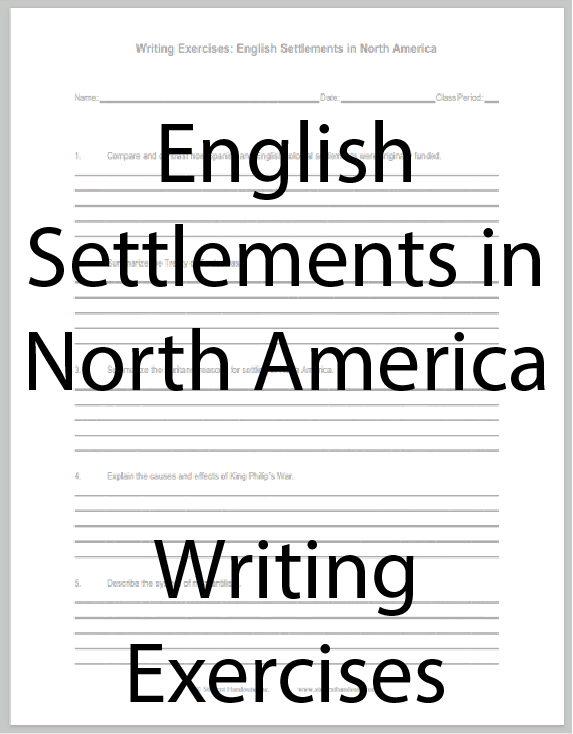| English Settlements in North America Writing Exercises |
|---|
| www.studenthandouts.com ↣ U.S. History ↣ Colonial Period ↣ Worksheets |
 |
   |
|
1. Compare and contrast how Spanish and English colonial settlements were originally funded. 2. Summarize the Treaty of Tordesillas. 3. Summarize the Puritans' reasons for settling in North America. 4. Explain the causes and effects of King Philip's War. 5. Describe the system of mercantilism. Click here to print. Answers will vary. Mercantilism was an economic system that dominated European economic thought and policy during the early modern period (16th to 18th centuries). It was characterized by several key principles and practices. Bullionism: Mercantilism emphasized the accumulation of precious metals, particularly gold and silver, as a measure of a nation's wealth. Colonies were seen as valuable because they could provide raw materials to the mother country, which could then be turned into finished goods for export, ultimately resulting in a favorable balance of trade and the accumulation of bullion. Colonialism and Imperialism: Mercantilist nations established colonies as sources of raw materials and as captive markets for their manufactured goods. Colonies were expected to provide valuable resources, such as timber, minerals, and agricultural products, to the mother country. Protectionism: Mercantilist policies often included protectionist measures such as tariffs, import restrictions, and monopolies. These policies were designed to protect domestic industries from foreign competition and ensure that the nation's exports exceeded its imports. Navigation Acts: Many mercantilist powers, including Britain, implemented Navigation Acts that regulated trade between colonies and the mother country. These acts required that certain goods be transported on domestic ships, controlled colonial exports, and limited economic independence in the colonies. State Intervention: Mercantilism advocated for strong government intervention in the economy. Governments provided subsidies to industries deemed essential, established monopolies, and regulated trade to promote economic growth and national power. Mercantilist Policies: Governments actively promoted and regulated industries that were believed to be in the national interest. For example, England invested in its textile industry, and France supported its manufacturing and luxury goods industries. Colonial Exploitation: Colonies were often viewed primarily as sources of wealth for the mother country. This led to the exploitation of resources and labor in colonies, sometimes resulting in economic and social inequality. Trade Surpluses: Mercantilism aimed to achieve a trade surplus, where a nation exported more goods than it imported. The surplus was believed to contribute to the accumulation of wealth in the form of bullion. Zero-Sum View: Mercantilism operated under a zero-sum view of trade, meaning that one nation's gain was seen as another's loss. This competitive approach led to conflicts over trade and resources among mercantilist powers. Critiques: Mercantilism has been criticized for its focus on bullion accumulation and trade surpluses, which some economists argue are not sustainable measures of a nation's wealth. It also faced moral and ethical criticisms, particularly regarding the exploitation of colonies. Mercantilism played a significant role in shaping the economic policies and practices of European powers during the colonial era. It influenced trade patterns, colonization efforts, and government intervention in economic affairs. Over time, mercantilism gave way to other economic theories, such as classical liberalism and free trade, as nations began to recognize the limitations and drawbacks of this system. |
| Colonial Period Books and Films | Colonial Period Learning and Study Games |
| Colonial Period Image Galleries | Colonial Period Outlines and PowerPoints |
| Colonial Period Miscellany | Colonial Period Worksheets |
| www.studenthandouts.com ↣ U.S. History ↣ Colonial Period ↣ Worksheets |








